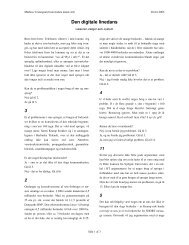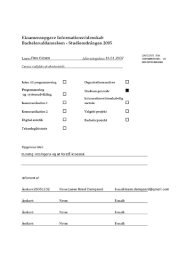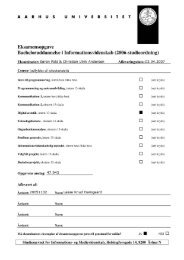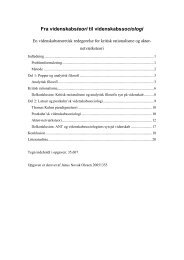Semiotics, Fashion and Cognition - Mathias Vestergaard Corp.
Semiotics, Fashion and Cognition - Mathias Vestergaard Corp.
Semiotics, Fashion and Cognition - Mathias Vestergaard Corp.
Create successful ePaper yourself
Turn your PDF publications into a flip-book with our unique Google optimized e-Paper software.
<strong>Mathias</strong> <strong>Vestergaard</strong> Jakobsen <strong>Semiotics</strong>, <strong>Fashion</strong> an <strong>Cognition</strong> 2008-06-11<br />
Introduction<br />
We all have an idea about what fashion is. We use the term in our daily language, <strong>and</strong> in the recent<br />
decades it has received an increasing amount of academic attention as well. Serious historical<br />
studies of dress have been conducted (Wilson, 2007), Rol<strong>and</strong> Barthes’s semiotic analyses of the<br />
language of fashion has been translated to English (1990), very specific visual aesthetic analyses of<br />
fashion photography have been (Andersen, 2006) <strong>and</strong> some have tried to integrate all these studies<br />
into an overall “fashion-ology” (Kawamura, 2006). Yet, there is no single focal point of attention<br />
that can capture the entire complexity of the fashion phenomenon. Additionally, there are many<br />
different <strong>and</strong> inconsistent definitions of what fashion really is. It is often confused with clothing in<br />
general or the concept of individual style, probably as a result of changing times, <strong>and</strong> the fact that<br />
fashion has evolved <strong>and</strong> changed.<br />
This paper focuses on fashion in the context of language. In addition to the examination of fashion<br />
<strong>and</strong> language this paper is also an attempt to open up a broader discussion about fashion in the<br />
cognitive tradition.<br />
Statement of intent<br />
How does the early Rol<strong>and</strong> Barthes describe the language of fashion? How can<br />
Rol<strong>and</strong> Barthes’s theory be revised to suit a cognitive semiotic language framework,<br />
including image schemas <strong>and</strong> mental models? What are the roles of fashion<br />
magazines <strong>and</strong> the actual clothing items?<br />
Method<br />
In order to satisfy the statement of intent, this paper has been divided into three sections. Section A<br />
describes Rol<strong>and</strong> Barthes’s earliest semiologically inspired view on the language of fashion. Taking<br />
the Saussurian distinction between ‘langue’ <strong>and</strong> ‘parole’ he examines fashion <strong>and</strong> especially the act<br />
of dressing. Also, he tries to establish the role of fashion magazines, <strong>and</strong> how they contribute in the<br />
production of fashion signs. Section B describes the basic foundations <strong>and</strong> premises for a cognitive<br />
semiotic framework for language, including frames, image schemas <strong>and</strong> cognitive mental models,<br />
thus providing the necessary background knowledge for a reexamination of Barthes’s fashion<br />
theory. Section C develops a hypothesis based on a fusion of sections A <strong>and</strong> B, integrating fashion<br />
as understood by the early Barthes into the cognitive framework of section B.<br />
Terminology<br />
When dealing with a complex <strong>and</strong> multifaceted subject as fashion, it is important to clarify what<br />
the term actually refers to in the given context. No coherent terminology has yet been established,<br />
<strong>and</strong> there are serious divergences to be found among authors. This list briefly shows the differences<br />
between the terms, as I will be using them in this paper.<br />
<strong>Fashion</strong> can be seen in both a broad <strong>and</strong> narrow sense. In the broad sense, fashion is the<br />
aggregated sum of all the different aspects of clothing, dressing, general consumption, economics,<br />
sociology, psychology, history, communication etc. This is the definition found in Lipovetsky<br />
(1994). In a narrower sense, fashion is an ever changing, <strong>and</strong> yet somewhat specific subset of the<br />
public taste (for clothing, food, furniture etc.). Defined partly by the fashion institutions’ own<br />
proclamation, <strong>and</strong> partly by the fact that this taste usually spreads out to the broader public, while<br />
Side 3 af 17








